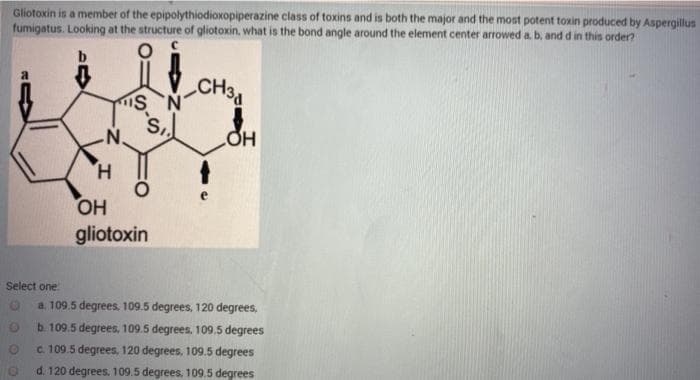Gliotoxin is a member of the epipolythiodioxopiperazine class of toxins and is both the major and the most potent toxin produced by Aspergillum fumigatus. Looking at the structure of gliotoxin, what is the bond angle around the element center arrowed a b, and d in this order? b. CH34 S N H. HO, gliotoxin Select one a. 109.5 degrees, 109.5 degrees, 120 degrees. b. 109.5 degrees, 109.5 degrees. 109.5 degrees c. 109.5 degrees, 120 degrees, 109.5 degrees d. 120 degrees. 109.5 degrees. 109.5 degrees
Gliotoxin is a member of the epipolythiodioxopiperazine class of toxins and is both the major and the most potent toxin produced by Aspergillum fumigatus. Looking at the structure of gliotoxin, what is the bond angle around the element center arrowed a b, and d in this order? b. CH34 S N H. HO, gliotoxin Select one a. 109.5 degrees, 109.5 degrees, 120 degrees. b. 109.5 degrees, 109.5 degrees. 109.5 degrees c. 109.5 degrees, 120 degrees, 109.5 degrees d. 120 degrees. 109.5 degrees. 109.5 degrees
Chemistry & Chemical Reactivity
9th Edition
ISBN:9781133949640
Author:John C. Kotz, Paul M. Treichel, John Townsend, David Treichel
Publisher:John C. Kotz, Paul M. Treichel, John Townsend, David Treichel
Chapter9: Bonding And Molecular Structure: Orbital Hybridization And Molecular Orbitals
Section: Chapter Questions
Problem 52IL: Ethylene oxide is an intermediate in the manufacture or ethylene glycol (antifreeze) and polyester...
Related questions
Question

Transcribed Image Text:Gliotoxin is a member of the epipolythiodioxopiperazine class of toxins and is both the major and the most potent toxin produced by Aspergillus
fumigatus. Looking at the structure of gliotoxin, what is the bond angle around the element center arrowed a. b, and d in this order?
CH34
N.
H.
gliotoxin
Select one
a. 109.5 degrees. 109.5 degrees, 120 degrees,
b. 109.5 degrees, 109.5 degrees. 109.5 degrees
c. 109.5 degrees, 120 degrees, 109.5 degrees
d. 120 degrees. 109.5 degrees, 109.5 degrees
Expert Solution
This question has been solved!
Explore an expertly crafted, step-by-step solution for a thorough understanding of key concepts.
Step by step
Solved in 2 steps

Knowledge Booster
Learn more about
Need a deep-dive on the concept behind this application? Look no further. Learn more about this topic, chemistry and related others by exploring similar questions and additional content below.Recommended textbooks for you

Chemistry & Chemical Reactivity
Chemistry
ISBN:
9781133949640
Author:
John C. Kotz, Paul M. Treichel, John Townsend, David Treichel
Publisher:
Cengage Learning

Chemistry & Chemical Reactivity
Chemistry
ISBN:
9781337399074
Author:
John C. Kotz, Paul M. Treichel, John Townsend, David Treichel
Publisher:
Cengage Learning

Organic Chemistry: A Guided Inquiry
Chemistry
ISBN:
9780618974122
Author:
Andrei Straumanis
Publisher:
Cengage Learning

Chemistry & Chemical Reactivity
Chemistry
ISBN:
9781133949640
Author:
John C. Kotz, Paul M. Treichel, John Townsend, David Treichel
Publisher:
Cengage Learning

Chemistry & Chemical Reactivity
Chemistry
ISBN:
9781337399074
Author:
John C. Kotz, Paul M. Treichel, John Townsend, David Treichel
Publisher:
Cengage Learning

Organic Chemistry: A Guided Inquiry
Chemistry
ISBN:
9780618974122
Author:
Andrei Straumanis
Publisher:
Cengage Learning

General Chemistry - Standalone book (MindTap Cour…
Chemistry
ISBN:
9781305580343
Author:
Steven D. Gammon, Ebbing, Darrell Ebbing, Steven D., Darrell; Gammon, Darrell Ebbing; Steven D. Gammon, Darrell D.; Gammon, Ebbing; Steven D. Gammon; Darrell
Publisher:
Cengage Learning

Chemistry: Principles and Practice
Chemistry
ISBN:
9780534420123
Author:
Daniel L. Reger, Scott R. Goode, David W. Ball, Edward Mercer
Publisher:
Cengage Learning

Chemistry by OpenStax (2015-05-04)
Chemistry
ISBN:
9781938168390
Author:
Klaus Theopold, Richard H Langley, Paul Flowers, William R. Robinson, Mark Blaser
Publisher:
OpenStax